Victorian Dairy Soils - Sandy soils
Back to: Victorian Dairy Soil
The most common sandy soils in Victorian dairy regions are Podosols (Australian Soil Classification). These are mainly sandy soils with accumulations of organic materials and aluminium (with or without iron compounds) - often referred to as “coffee rock” - occurring in subsoil horizons. Other sandy soils are generally Tenosols associated with older prior streams or in current floodplain areas.
Distribution
| In Gippsland, along parts of the coastline and in some inland dunefield areas, siliceous sands have been deposited by wind during the Holocene period. Podosols occur on French Island, around Nyora and on inland dunefields and sand plains across southern and eastern parts of the region (south of Traralgon). Aeric Podosols generally occur on well drained dunes and Aquic Podosols generally occur in poorly drained lower-lying areas between dunes. Soil pite site SG10 is an example of an Aeric Podosol profile near Tarwin Lower. Soil pit site SG9 is an example of an Aquic Podosol in the same area. | 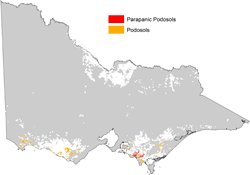 |
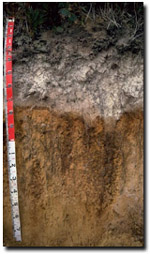 Aeric Podosol in West Gippsland | 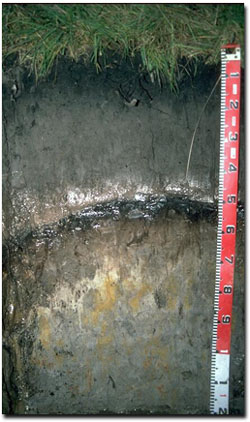 Aquic Podosol in West Gippsland |
| South of Leongatha, Podosols occur (along with other soils) on Tertiary and early Pleistocene sediments. These have been formed within the surface horizons of older soil profiles These particular soils have an extremely hard layer below the surface (referred to as Parapanic in the Australian Soil Classification). Soil pit site SG3 is an example of a Parapanic Podosol near Inverloch. | 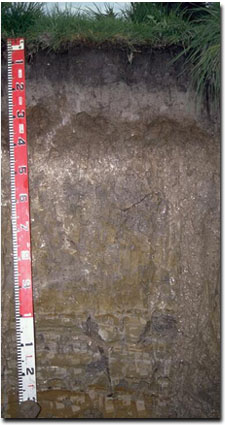 |
| Podosols are also reasonably common in the southern parts of the South-West dairy region, associated with Quaternary windblown siliceous sand deposits (e.g. in the Heytesbury district and to the south of Colac). Soil pit site SW61 is an example of a Podosol near Simpson. | 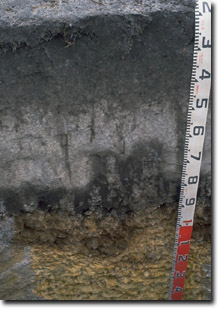 Podosol soil profile near Simpson in South-West Victoria |
Management Considerations
Podosols are inherently infertile and require trace elements as well as superphosphate and potash in order to grow good pasture. Below are a range of management considerations for these soils.
Plant Available Water Capacity (PAWC) is generally considered to be very low. These sandy soils retain little water and are very low in nutrients. However, with irrigation, fertilisers and additional organic matter they can become highly productive. The low wilting point value, however, indicates that plants will be able to utilise light rains falling on relatively dry soils. However, due to the low water storage capacity, plants will soon suffer moisture stress unless further rainfall occurs. Organic matter is important in these sandy soils to enhance water holding capacity. The sandy surface horizons are very well drained but will be prone to wind erosion if plant cover is removed.
Deficiencies of trace elements such as copper, zinc and molybdenum are likely to occur, but should be confirmed by plant tissue analysis. Such strongly leached soils are also likely to be naturally deficient in nitrogen, phosphorus, sulphur and potassium. Regular fertiliser inputs are required for improved pasture or vegetable cropping. Nitrate and sulphate are readily soluble and easily removed by leaching. More regular but smaller applications of fertiliser will assist in reducing loss of nutrients through leaching and is likely to be deficient in nitrogen, phosphorus and potassium. The bleached sub-surface (A2) horizon is extremely infertile, so building up the surface (A1) horizon should be an objective.
Deficiencies of the trace element molybdenum (Mo) are likely to occur in these acidic sandy soils (soil adsorption of Mo increases as pH decreases, leading to reduced availability to plants). Any deficiencies can be confirmed by plant tissue analysis. Deficiencies can be remedied with molybdenum-enriched fertiliser and foliar application. Lime application will result in increased pH levels and make certain nutrients such as phosphorus and molybdenum more available to plants. Nutrients such as calcium and magnesium are also usually low in strongly acid soils. Magnesium deficiency can be assessed by plant tissue analysis and treated by applying dolomite to the soil or using a foliar spray. The trace element boron (B) leaches rapidly through acid sandy soils and deficiencies are likely to occur. Over-liming in sandy soils can make trace elements such as boron, zinc and manganese less available. Organic matter can complex with metal ions enabling trace elements (Fe, Zn, Cu) to become more available to plants.
The "coffee rock" layer may restrict the downward movement of plant roots and water, in which case subsurface drainage may be required. In some situations, the build-up of water on top of the less permeable layer may be beneficial in that it prevents deep drainage of water away from plant roots. Podosols with an extremely hardened subsurface layer (i.e. Parapanic) occur in southern Gippsland and present significant restriction to root and water movement. Waterlogging is commonly associated with these soils in wet seasons.


